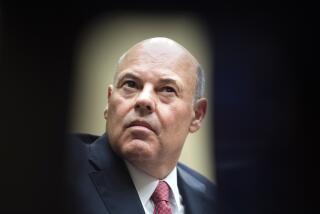Why We Have a Federal Monopoly for the Mail
- Share via
The July 2 edition of the Los Angeles Times carried a column by Doug Bandow of the Cato Institute in which he wrote: “There is no excuse for continuing the federal postal monopoly.” Just the opposite is true.
The private express statutes, in one form or another, have been the law for nearly 200 years because Congress determined they provide the best means to serve the interests of all Americans.
Even with the growth of private delivery firms, the Postal Service remains the only universal, comprehensive delivery system in the United States.
With all due respect to Bandow, the private express statutes are not an “excuse.” They are a safeguard.
Bandow contends current mail delivery is 10% slower than in 1969. It would be fascinating to learn how he arrived at that conclusion. First, the method of measuring speed of delivery since postal reorganization has changed so dramatically as to make a comparison nearly impossible. Second, outmoded mail handling methods and labor unrest led to such service deterioration in 1969 that the Postal Reorganization Act of 1970 was the result.
With the U.S. taxpayer subsidizing the Post Office Department in 1969 to the tune of more than $1 billion, the department had a deficit of $319 million.
Compare that to today’s Postal Service, which--without federal subsidy since 1982--is likely to finish this year with a net surplus of approximately $414 million and has broken even or better in all but one year since the change. Keep in mind, the U.S. Postal Service delivers mail to more than 104 million addresses throughout the country--not only in the “profitable,” high-density areas private firms are so eager to serve, but to every inner-city neighborhood and farm in the nation.
And mail volume is 71% greater today than it was in 1969 (140.1 billion pieces in fiscal year 1985 compared to 82 billion).
What’s more, first-class, stamped, overnight mail presently is meeting its performance standard 96% of the time. And we do it for about the same cost to the mailer, adjusted for inflation, as we did in 1971. In fact, today’s 22-cent stamp, when adjusted for inflation, is the equivalent of the 8-cent stamp of 1971. And when we take into account that we no longer get the 2- or 3-cent per item subsidy--we are actually carrying the mail for 20% to 25% less than it cost taxpayers in 1971.
If Bandow truly believes “there is no doubt private firms could do a better job delivering the mail” and better serve the interest of customers, let him answer these questions:
Who would offer universal mail service to every address--including rural and inner-city America--at a uniform rate? Who would forward approximately 40 million pieces of mail a year, and staff and train a Postal Inspection Service to protect customers against mail fraud and theft? Who would be willing to maintain more than 39,000 postal facilities around the country on agreements with 160 nations around the world?
FRANK S. JOHNSON JR.
Assistant Postmaster General
Communications Department
Washington
More to Read
Sign up for Essential California
The most important California stories and recommendations in your inbox every morning.
You may occasionally receive promotional content from the Los Angeles Times.













